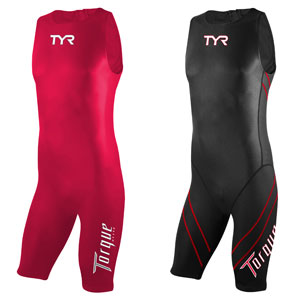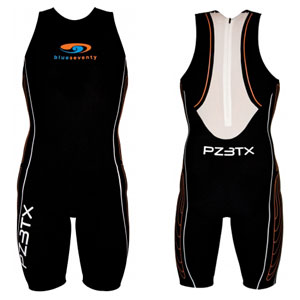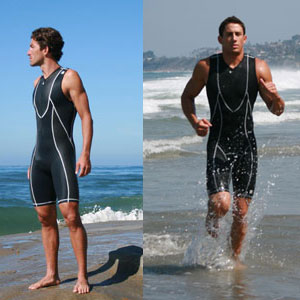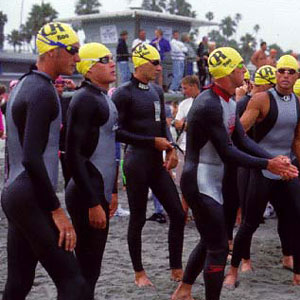Kona legal swim skins

"Life moves pretty fast," noted Ferris Bueller. " If you don't stop and look around once in a while, you could miss it." So true.
You could miss, for example, all the new rules about what you can and can't wear at what—for a lot of you—is your A-race coming up the second Saturday in October. The rules are largely in accord with FINA's rules, except that FINA has different rules for pool versus open water swimming, and WTC's rules allow for a zippered entry, while FINA does not.
But you don't care about the details, you just want to know what's legal, what's fast, and what's available, right? We don't have the exhaustive list, but, here are three companies making such products, with a look at the items themselves.
TYR Torque
This might be the hottest item in the category right now, because it's the closest thing to what TYR's competitive swimmers are wearing in the pool. There are two Torque models, the Elite ($250) and the Pro ($350). The Pro comes in black, and is pictured above. the Elite comes in red or black, and the red version is pictured alongside.
"Now we have a textile-based swimskin that's legal in a WTC race," said TYR's Ryan Dolan. "We went exactly down the WTC rule line. The Torque doesn't cover the neck, nor the shoulders, it's knee length. The Torque does have a zipper."
The point of this product is to function as a swim-leg-only garment. Either the Torque Pro or Elite can be worn as a swimskin, to be doffed in favor of riding apparel after the swim, or it can be worn over, say, a one-piece cycling skinsuit. It's not a trisuit in which you can race the entire event, nor even a swim/bike garment—the fit and fabric are probably too compressive for the bike.
Torque Elite's fabric is papery thin, with bonded seams. The Torque Pro is a polyester knit suit that feels more like polyurethane or neoprene suit, but, is legal.
Here's an inside tip: Chrissie Wellington is going to be wearing the pricier Pro model, with its flatlock seams and fabric more familiar in feel to the now illegal swim skins of the past couple of years. But you'll probably see Iron swim specialist John Flanagan in the Elite. This, because its welded seams, light weight and compressive fit are just what pure swimmers want (Flanagan is not a pure swimmer any longer, but, is still closely associated with that milieu; one can understand his choice of swim skin).
Take the zipper out of the Elite, you basically have TYR's B series swimskins favored by so many pool swimmers. The pool racing version is the Tracer B series. If you move to a zipperless version of the Torque Elite the Tracer B is more or less what you have.
TYR's C series is analogous to the Torque Pro swimskin, and, even though it's more expensive and upscale, most elite swimmers choose B series versus C series for pool racing.

Bottom line: Maybe it's best to save $100 and buy the Torque Elite, if you're going to trust the pure swimmers, and assume they know what they're doing; maybe that's the better suit at any price.
Andy Potts, now more a triathlete, with those swimmers chromosomes out of his system, is reportedly teetering between the Pro and the Elite for his Kona race.
Blueseventy PZ3TX
This $295 garment (pictured adjacent) is Blueseventy's answer to the new WTC rules. It's got a zippered back, is completely fabric in its construction (no rubber or SCS, in keeping with WTC's rules) and has welded seams, like TYR's Torque Elite.
The material in the PZ3TX is identical to the that Blueseventy places into the Nero TX used by competitive pure swimmers.
Note that this is the garment that's Kona legal. Blueseventy's other skinsuits—the Pointzero3, the Nero Comp and the Nero 10k—are not WTC approved for the Hawaiian Ironman.
This suit is hot off the presses, and, is not currently available. Blueseventy is taking orders, and your suit will be available for pick up once you alight on the Big Island.
The PZ3TX will be well represented in Kona; the entire TBB Team who're Kona qualified will be wearing this suit. Also, you should see it on Luke McKenzie, Cat Morrison, Maik Twelsiek, Rasmus Henning, Kate Snow, Rutger Beke, Ben Hoffman, Fraser Cartmell, Rebekah Keat, Eduardo Sturla, Leanda Cave, Dirk Bockel, Timo Bracht, Michael Lovato, Chris McDonald and others.

De Soto Liftfoil Speed Trisuit
This product incorporates a tactical element to its design that you might expect from a former pro triathlete like Emilio De Soto. The Liftfoil Speed Trisuit, while designed in most respects like a pure swim skin, has a water repellent pad reminiscent of trisuits. Because it resists water, the pad itself exhibits positive buoyancy. But the buoyancy is not its only purpose.
The suit is "enough" trisuit to be used throughout an event—though it lacks any pockets or similar features that might slow it down in the swim—and it's certainly enough garment for the bike. The tactical issue in a full or half-Ironman is: Did you have the swim you planned once you exit the water?
"What I might do," reasons De Soto, "is have my cycling garments in a change bag, and that might be my plan. However, if the train is leaving the station as I'm leaving T1, perhaps I might pass the change tent by."
This is the tactical flexibility De Soto's swim skin grants its wearer. Note that this suit features a front zipper, whereas the typical swim skin's zipper is in the rear. This makes the De Soto suit easy to remove, and, it's a suit that allows for ventilation if worn on a dry land leg of the race.
But placing the zipper in the front is not—if you talk to the makers of swim-only skins—what you do if you want to make the fastest possible swim-only garment.
De Soto makes this suit in both men's and women's sizes and styles.
Where will you use this style of garment?
How often will you use this sort of swimskin, and where? It's primary use will be in Ironman and 70.3 events that are not wetsuit legal. So, the Hawaiian Ironman, Ironman Cozumel, and, for example, a race four days from now, as of this writing: 70.3 Cancun.



Start the discussion at slowtwitch.northend.network